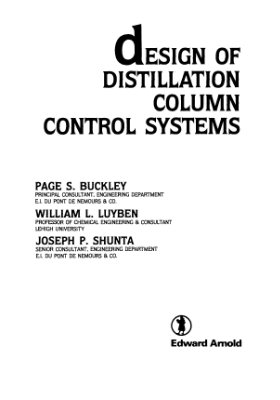Edward Aold, 1985. – 530 p.
This is a book about the design of distillation column control systems. It is written primarily from the standpoint of an engineering design organization, and is based on years of experience with large design projects as well as on personal plant experience. Most new investment dollars go into new or modeized facilities, and it is in the design phase of projects for these facilities that the most opportunities occur and flexibility exists to influence process control. Consequently this book is aimed primarily at design personnel. It is our hope, however, that it will also be useful to those who have to operate or troubleshoot existing plants.
Part I is an introduction, including a perspective on control and a brief review of fundamentals of distillation, with emphasis on topics that will be of interest to the control engineer rather than to the column design engineer. The distillation review, it is hoped, will be particularly useful to nonchemical engineers.
Part II of the book, on concepts and configurations, discusses some practical aspects of distillation control. Once the requirements for a particular column in a particular process are understood, design engineers must make at least a preliminary choice of equipment arrangements and control system configuration. In this section we have mostly avoided the use of mathematics and control theory. It is our hope that our discussions of equipment and control system arrangements will be useful to process engineers, production supervisors, main-tenance engineers, and instrument engineers seeking guidelines, alteatives, and perspectives.
Part III focuses on the quantitative design of distillation control systems. It is aimed at professional control engineers and any others conceed with the numerical definition and specification of control system performance.
Probably the most important development in process control system design since about 1950 was the evolution of a substantial body of theory and mathematics, plus a large catalog of control system studies. Together, these permit quantitative design of most process control systems with a considerable degree of multivariable control. It is the purpose of this book to indicate the range of this technology, which has been developed for distillation control, to the point where it can be economically and reliably used for design.
This is a book about the design of distillation column control systems. It is written primarily from the standpoint of an engineering design organization, and is based on years of experience with large design projects as well as on personal plant experience. Most new investment dollars go into new or modeized facilities, and it is in the design phase of projects for these facilities that the most opportunities occur and flexibility exists to influence process control. Consequently this book is aimed primarily at design personnel. It is our hope, however, that it will also be useful to those who have to operate or troubleshoot existing plants.
Part I is an introduction, including a perspective on control and a brief review of fundamentals of distillation, with emphasis on topics that will be of interest to the control engineer rather than to the column design engineer. The distillation review, it is hoped, will be particularly useful to nonchemical engineers.
Part II of the book, on concepts and configurations, discusses some practical aspects of distillation control. Once the requirements for a particular column in a particular process are understood, design engineers must make at least a preliminary choice of equipment arrangements and control system configuration. In this section we have mostly avoided the use of mathematics and control theory. It is our hope that our discussions of equipment and control system arrangements will be useful to process engineers, production supervisors, main-tenance engineers, and instrument engineers seeking guidelines, alteatives, and perspectives.
Part III focuses on the quantitative design of distillation control systems. It is aimed at professional control engineers and any others conceed with the numerical definition and specification of control system performance.
Probably the most important development in process control system design since about 1950 was the evolution of a substantial body of theory and mathematics, plus a large catalog of control system studies. Together, these permit quantitative design of most process control systems with a considerable degree of multivariable control. It is the purpose of this book to indicate the range of this technology, which has been developed for distillation control, to the point where it can be economically and reliably used for design.

